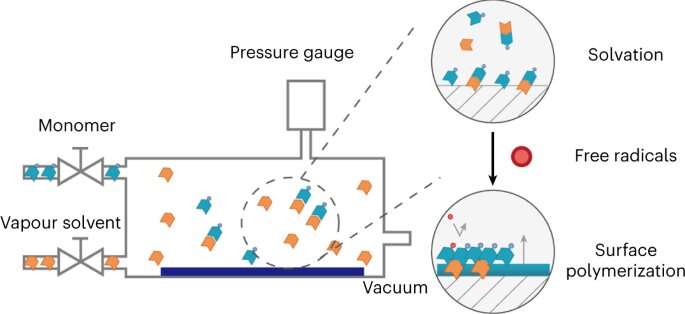This article has been reviewed according to Science X's editorial process and policies. Editors have highlighted the following attributes while ensuring the content's credibility:
fact-checked
peer-reviewed publication
trusted source
proofread
'Magic' solvent creates stronger thin films

A new all-dry polymerization technique uses reactive vapors to create thin films with enhanced properties, such as mechanical strength, kinetics and morphology. The synthesis process is gentler on the environment than traditional high-temperature or solution-based manufacturing and could lead to improved polymer coatings for microelectronics, advanced batteries and therapeutics.
"This scalable technique of initiated chemical vapor deposition polymerization allows us to make new materials, without redesigning or revamping the whole chemistry. We just simply add an 'active' solvent," said Rong Yang, assistant professor in the Smith School of Chemical and Biomolecular Engineering in Cornell Engineering. "It's a little bit like a Lego. You team up with a new connecting piece. There's a ton you can build now that you couldn't do before."
Yang collaborated on the project with Jingjie Yeo, assistant professor in the Sibley School of Mechanical and Aerospace Engineering, and Shefford Baker, associate professor of materials science and engineering.
The group's paper, "Engineering Solvation in Initiated Chemical Vapour Deposition for Control over Polymerization Kinetics and Material Properties," published Feb. 9 in Nature Synthesis. The lead author is doctoral student Pengyu Chen. Yang and Yeo are co-senior authors.
Chemical vapor deposition (CVD) is a common process used to make defect-free inorganic nanolayer materials in semiconductor manufacturing and in the production of computer microchips. Because the process requires materials to be heated at thousands of degrees, organic polymers do not fare well. CVD polymerization techniques such as initiated CVD (iCVD) are low-temperature counterparts developed for polymer synthesis. However, it is also limiting, Yang said, because "over the years, people have grown to the boundary of the chemistry you can make with this method."
Yang's lab studies how vapor-deposited polymers interact with bacterial pathogens and how bacteria, in turn, colonize polymeric coatings, from the paint used in ship hulls to the coating for biomedical devices. She and Chen sought to develop a different approach to diversify CVD polymers by borrowing a concept from conventional solutions synthesis: the use of a "magic" solvent, i.e., an inert vapor molecule, that isn't incorporated into the final material, but instead interacts with a precursor in a way that produces new material properties at room temperature.
"It's an old chemistry but with new features," Yang said.
The solvent in this case interacted with a common CVD monomer via hydrogen-bonding. "It is a novel mechanism, although the concept is simple and elegant," Chen said. "Building on this interesting strategy, we are developing a robust and generalizable science of solvation engineering."
Yang and Chen then turned to Yeo, whose lab simulated the molecular dynamics behind the solvent and monomer interaction, and how their stoichiometry, or chemical balance, could be tuned.
"We distinguished the effects of different solvents at the molecular scale and we clearly observed which solvent molecules were more inclined to bind with the monomer," Yeo said. "Thus, we can eventually screen which Lego pieces will be able to fit best with each other."
The researchers brought the resulting thin film to Baker's lab, which used nanoindentation testing to study it and found that the solvation mechanism had strengthened the material. The solvent also caused the polymer coating to grow faster and change its morphology.
This method can now be applied to various methacrylate and vinyl monomers—for essentially anything with a polymer coating, such as the dielectric materials in microelectronics, the anti-fouling coating in ship hulls, and the separation membranes that enable purification in wastewater treatment. The technique could also allow researchers to manipulate the permeability of pharmaceutical products for controlled drug release.
"This adds a new dimension to materials design. You can imagine all kinds of solvents that could form hydrogen-bonding with the monomer and manipulate the reaction kinetics differently. Or you can have solvent molecules incorporated into your material permanently, if you design the molecular interaction correctly," Yang said. "There's so much to explore with this added degree of freedom going forward."
Co-authors include Baker, Zheyuan Zhang, and Zach Rouse.
More information: Pengyu Chen et al, Engineering solvation in initiated chemical vapour deposition for control over polymerization kinetics and material properties, Nature Synthesis (2023). DOI: 10.1038/s44160-023-00242-5
Journal information: Nature Synthesis
Provided by Cornell University





















